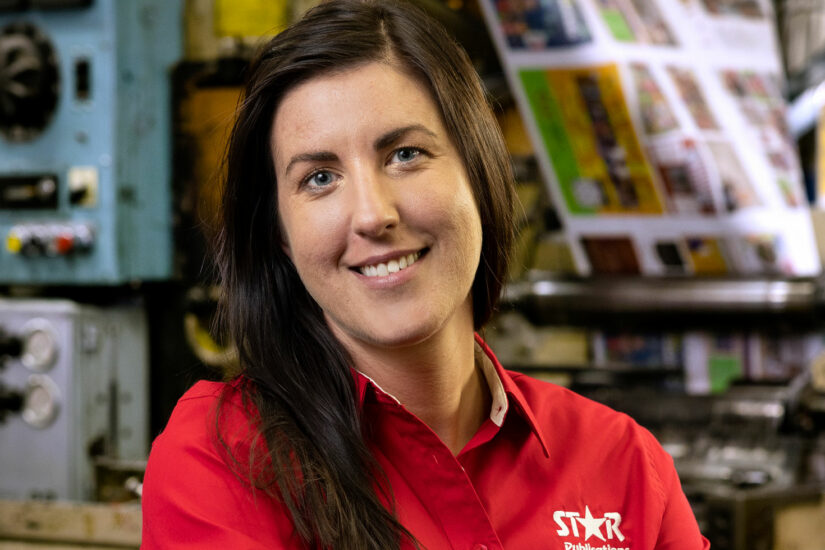
Turning the Page
Challenged by shrinking local newsrooms and changing readership, rural communities look for new ways to connect and tell their stories
By Laura Billings Coleman | Photography by Paul Middlestaedt
Public trust of the media is at an all-time low, with nearly four in 10 Americans reporting they have no confidence in newspapers, TV and radio, according to a recent Gallup poll.
But those numbers don’t mean much to Natasha Barber, the managing editor of Star Publications, which owns several newspapers in Central Minnesota, including the Sauk Rapids Herald, Benton County News, The Star Post, and Sauk Centre Herald. A trusted and familiar face in her community, Barber is frequently the only non-official in attendance at school board sessions, zoning meetings and other public functions, keeping a watch on local government while covering everything from summertime boat parades and new business expansions, to the hyperlocal implications of Minnesota’s new cannabis laws.
“People definitely return my calls here,” says Barber, who grew up in the area and fondly remembers seeing her first letter to the editor published while she was still a student. The editor of the Sauk Rapids Herald since 2015, and co-owner of Star Publications since 2019, Barber says her newspaper’s niche is “all about telling the human interest, hometown stories that you won’t see anywhere else. I think that’s why people tell us they love the paper—but whether they want to support it financially, that’s a whole different ball game.”
Challenged by everything from changing readership patterns to the rise of Craigslist and the fall of traditional advertising revenue, the decline of local newspapers is a national trend that’s been playing out since the 1990s. But now there’s evidence that media consolidation and mergers, along with the growth of social network news silos, are having an outsize impact on rural areas. According to a recent report from the Mankato-based Center for Rural Policy and Development (CRPD), Minnesota has lost nearly a quarter of its newspapers and 70 percent of its news-related workforce over the last two decades. Sixty percent of those losses are concentrated in Greater Minnesota. As small daily and weekly newspapers continue to close (at a rate of two a week across the country), and as automakers like Ford and Tesla toy with eliminating AM radio from new model cars, many rural communities are now at risk of becoming “news deserts,” with no meaningful or reliable coverage of local events.
“The risk of losing a newspaper should be a concern to anyone in a community,” says Lisa Hills, executive director of the Minnesota Newspaper Association (MNA), a 150-year-old organization that serves roughly 265 Minnesota newspapers. “Study after study shows that losing coverage results in a loss of civic engagement.” Rebuild Local News is a nonpartisan coalition of more than 3,000 family-owned newspapers, journalism-focused nonprofits and civic groups. It found that communities with less local news coverage have lower voter turnout, fewer contested government races, higher taxes, lower bond ratings, more public health problems, government waste, corporate crime, and deeper polarization. Losing a local news source can also mean there’s no common ground where a community can share news of its births and deaths, new businesses and big dreams, school fundraisers and featured players. As Marnie Warner, vice president of research at CRPD, and author of the recent rural news report says, “A newspaper is a tie that binds a community together, and it’s hard to find a substitute for that.”

A NEW LANDSCAPE FOR LOCAL NEWS
In some parts of the country, the problem has grown so dire that lawmakers are getting involved. Minnesota Sen. Amy Klobuchar recently came out in favor of the Journalism Competition and Preservation Act, a plan that would allow newspapers to negotiate better terms with social media platforms that publish newspaper content without paying for it. “What does Big Tech’s dominance over the news mean for Americans?” Klobuchar, the daughter of a newspaper columnist, asked during a hearing. “Less revenue for local news, fewer journalists to do in-depth, high-quality reporting, more exposure to misinformation and fewer reliable sources.”
Currently, Minnesota has no official “news deserts”—every county but one is served by at least one local paper. But from the recent collapse of the St. Cloud Times—a so-called “ghost paper” with one newsroom staff member at the time this edition of IQ Magazine went to press—to the closure of historic papers like the Askov American (whose founder Hjalmer Petersen once claimed to have the largest circulation of any small-town paper in the country), there’s growing urgency around protecting the large role small-town newspapers play in public life. “Having a strong community news organization is often an indicator of having a strong community, period,” says Bob McClintick, the Initiative Foundation’s marketing and communications director. “As the region continues to recover from the pandemic, we see local news as one of the essential building blocks in helping communities overcome social isolation and staying connected.”
A Northwestern University study found the pandemic delivered a death blow to many newsrooms, with more than 360 papers going out of business between 2019 and 2022. Paradoxically, the public health crisis also reminded many readers of the power of print, says Jeff Andres, group publisher of Northstar Media/Kanabec Publications, which publishes the Isanti-Chisago County Star, Braham Journal, Pine City Pioneer, North Pine County News, Moose Lake Star Gazette, The Evergreen, and the Kanabec County Times. “During COVID, people really wanted good sources of local information and they turned back to local papers and have continued with those papers,” he says. While his company consolidated the former Askov American, Pine Courier, and the Hinckley News into what’s now the North Pine County News, they’ve also seen large circulation gains in several communities. “I don’t want to use the word resurgence, because it will never go back to the way it was. But it’s healthy.”
Lisa Schwarz, development and communications director for the MNA, says she’s seeing the same trends across the state. Several mergers have helped to preserve local coverage in communities where newspapers would have closed, and new publications have appeared in Osakis, International Falls, and Waseca (population 9,241), which may now be one of the nation’s smallest two-newspaper markets. “I’ll quote Mark Twain and say that the reports of the newspaper’s death have been greatly exaggerated,” says Schwarz, who served as the St. Cloud Times’ last lead editor. “The changes in this industry are cataclysmic, but they’re not catastrophic. I think the story is as much about how our Minnesota towns are doing as it is about how our newspapers are doing. If towns are healthy with commerce and advertisers, their newspaper tends to be very healthy. If they don’t have a business or industry base in the community, that newspaper is going to struggle.”
LOOKING FOR LOCAL SOLUTIONS
That connection between vibrant communities and healthy newsrooms explains why strengthening the capacity of outstate newsrooms is becoming a priority project across Greater Minnesota. For instance, the Blandin Foundation recently invested $500,000 in the Northern Community News Initiative, an effort to build the capacity of Grand Rapids’ KAXE, the first rural public radio station in the nation, which also serves Brainerd and Bemidji. This summer, the station posted help-wanted ads for several new hires, including two general assignment reporters–roles that can be harder to fill in Greater Minnesota.
“Staffing has become a real challenge,” says Andres, who says the once steady supply of new journalism school graduates eager for a byline has dwindled in recent years. “The industry as a whole also underpays, and has forever, and that’s going to continue the urban bias that a lot of young people have,” Schwarz says. “But if you can get them out into these communities, meeting people and telling stories, in a few months, they are going to fall in love with it.” This summer, MNA’s nonprofit arm, the Minnesota News Media Institute, funded 12 internship positions at member papers across the state. “We had applications from 36 newspapers, so if we had more funding, we could support even more papers,” she says.

MNA and Bethel University also launched Citizen Journalism University, a free, five-session workshop designed to empower citizen journalists to help tell the stories of their communities. English and journalism professor Scott Winter, who created the curriculum, says the new class, which will be offered again this fall, attracted a range of students, from suburbanites looking for second careers to local sports fans and retired teachers. Of the more than 20 participants in the inaugural class, several have already found their way into freelance gigs and full-time employment, including Anja Wuolu, who got her first bylines in her hometown paper of the St. Joseph Leader while she was taking the class. “I hadn’t even realized that regular people can just go to a city council meeting. I learned that those meetings can be tedious, but they’re also where so many decisions are made,” says Wuolu, who has since become a community editor at the Sun Post, a suburban newspaper that covers the suburbs of Crystal, Robbinsdale, New Hope and Golden Valley.
While Winter acknowledges that citizen journalism can’t close all the gaps in rural reporting, he believes training more students on everything from media ethics to the inverted pyramid style of writing may help create more informed readers who understand the difference between neutral reporting and punditry, and who create more demand for meaningful local coverage. “Being a journalism educator means having an existential crisis every week when your best students get offered jobs in business that pay twice what they’d pay in newspapers,” he says. “But I do believe greater media literacy will be one of the key components to solving this problem.”
While the shift to digital-first platforms has added new voices like MinnPost and Sahan Journal to the metro area, so far, internet-only solutions have lagged in rural areas. According to Rebuild Local News, no digital start-up has stepped in to save the 90 percent of communities that have lost a newspaper. Creating community-supported, nonprofit news models has also been a challenge in outstate areas that lack substantial philanthropic resources—not that it’s stopping 2022-23 Initiators Fellow Nora Hertel from launching Project Optimist, a solutions-focused news and storytelling site for Central Minnesota.
An award-winning investigative reporter, Hertel believes some of the blame for dwindling readership lies in the way news is covered, with a numbing emphasis on societal problems and political divisiveness. As a consequence, one recent study found that nearly 30 percent of the public now actively avoids the news. “When local newsrooms can’t meet a community’s needs, readers have to turn to national media, which is more polarizing and often more negative,” says Hertel, who has become a proponent of solutions journalism, a growing movement to bring rigorous, evidence-based reporting to explore promising solutions to community problems.
Earlier this year, the Initiative Foundation helped support a student journalist training session that Project Optimist offered in partnership with the Greater St. Cloud Development Corporation, where 17-year-old Ifrah Aden, a rising senior at Apollo High School, learned some of the basics about news gathering and storytelling about her community. “Being a journalist is now the number one job I’d like to have someday,” says Aden, who is currently at work on her first big article, an exploration of the mental health struggles faced by St. Cloud’s immigrant community and the stigma surrounding treatment. “It’s kind of a taboo subject, but I think the stories of everyday people are important to hear.”
Hertel couldn’t agree more. “Journalism is very much a calling,” she says. “I had a colleague who used to say it’s a combination of public service, art and business.” When it’s done right, she says, “we can provide people with a sense of possibility, and good reasons to engage with democracy.”